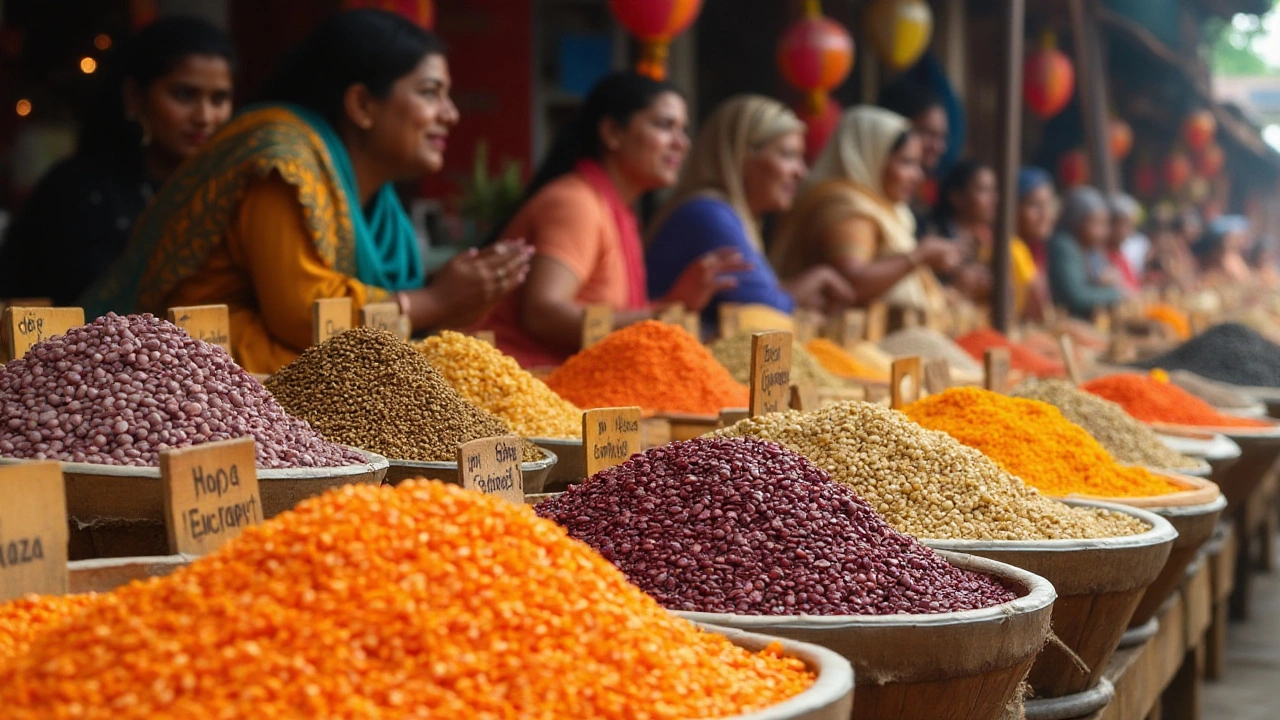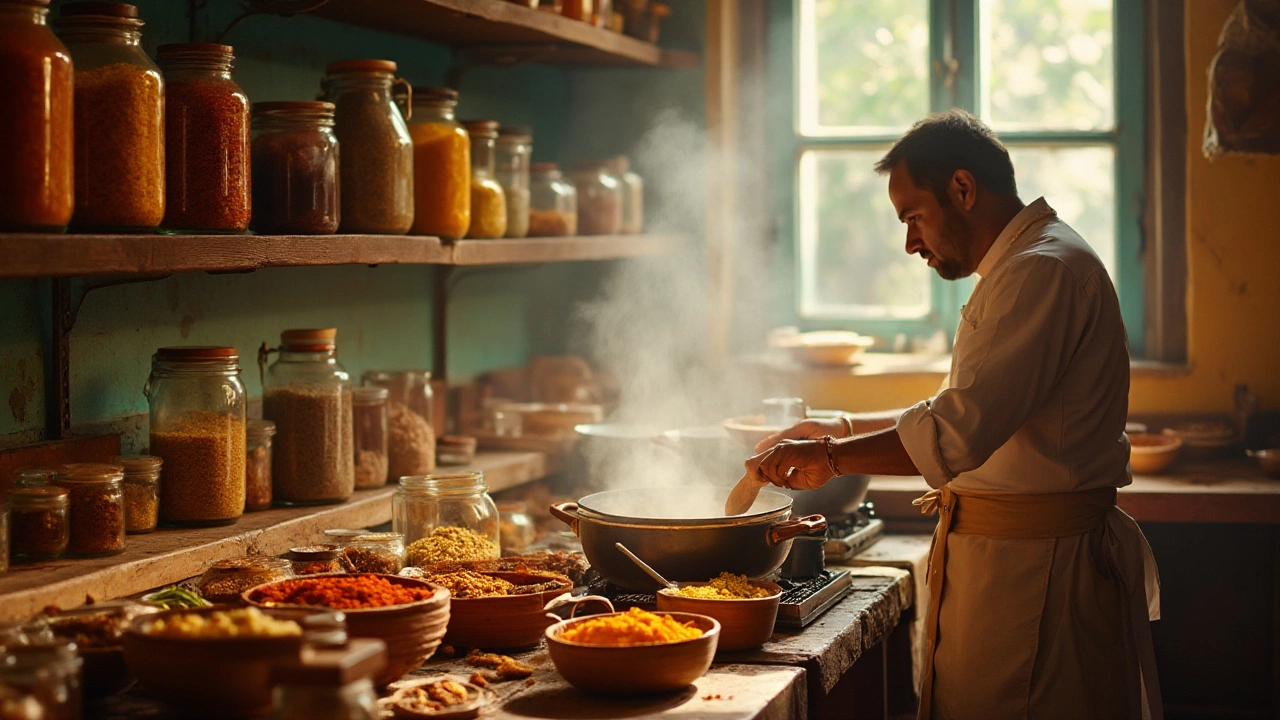Journey through the culinary world of dal, a humble yet versatile ingredient that has seamlessly made its way into American kitchens. While in its native Indian roots, dal refers to the split pulses cooked into a comforting dish, in the U.S., it commonly goes by the name 'lentils.' These small gems of nutrition add delectable depth to countless meals, often cherished for their flavor and health benefits.
Dive into the captivating story of dal's translation into Western culture, where it has not only retained its authenticity but also adapted wonderfully to local tastes. This piece unveils the different varieties Americans welcome into their homes, from their local grocery shelves to their hearty dinner plates.
With a simple recipe to whip up an irresistible dal dish, this guide aims to bridge traditional flavor with everyday American dining – a fusion that delights both heart and palate.
- Understanding Dal and Its Importance
- What Americans Call Dal
- Types of Dal Common in America
- Integrating Dal into Western Dishes
- A Simple and Delicious Dal Recipe
Understanding Dal and Its Importance
Dal, revered as the backbone of Indian cuisine, holds a special place due to its nutritional value and culinary versatility. Originating from the Indian subcontinent, dal refers to the split form of pulses, primarily lentils, peas, and beans — a category integral to the diet of millions. Historically, dal has been a significant part of the agricultural and food culture due to its resilience in various climates and its essential role as a protein source, especially in vegetarian diets. In myriad forms and preparations, dal offers an affordable and richly nourishing meal, providing both flavor and sustenance. Its importance extends beyond nutrition into the realm of tradition and communal rituals, often featured in festivals and family gatherings.
The nutritional profile of dal cannot be overstated. A rich source of protein, fiber, vitamins, and essential minerals, it is particularly crucial in regions where vegetarianism prevails. Lentils, among other legumes categorized as dal, are celebrated for their low-fat content and their ability to stabilize blood sugar levels, hence being recommended for people managing diabetes. The various types, from the red and yellow lentils to the slightly nutty whole black gram, each bring unique tastes and health benefits. According to dietitian Priya Tew, “Including a variety of dals in one's diet can lead to numerous health benefits due to their rich nutrient content.”
"Dal is to Indian cuisine what water is to the ocean – fundamental and omnipresent," says Madhur Jaffrey, a noted food writer and culinary historian, emphasizing its ubiquitous role in daily meals.
Beyond health, dal occupies a cherished place in social and cultural spheres. Whether it's the humble home-cooked dal that's comforted generations or the exquisite dals served in royal feasts, it epitomizes the diversity and ingenuity of culinary practices. Cooked with spices, herbs, and occasionally a hint of ghee, dal transforms into a dish that is at once basic and deeply satisfying. Moreover, it acts as a canvas reflecting regional tastes and techniques, from the spicy notes of a South Indian sambar to the creamy richness of the North Indian dal makhani.
Understanding dal also involves recognizing its adaptability, which has allowed it to transcend borders and integrate into cuisines globally, including American cuisine. In the U.S., lentils have gained popularity not just as an exotic ingredient but also as a health food staple. As people become more conscious of sustainable and plant-based eating, dal represents a perfect meld of health, taste, and tradition. It's transformed into soups, salads, and even burgers, illustrating how traditional foods evolve and thrive in new contexts.
What Americans Call Dal
In the mosaic of food cultures found across the United States, dal has emerged as an intriguing culinary inclusion. Often labeled simply as 'lentils,' it represents more than just a legume in Indian cuisine—it's a cornerstone of daily meals, a symbol of nourishment. America has welcomed dal with open arms, adopting it under the familiar guise of lentils which fits snugly into various culinary adventures. When Americans refer to dal, they might be speaking of the versatile lentil, a term that encompasses more than just one variety. Boasting multiple forms such as red, green, and brown lentils, the appreciation for their delicate flavor and delightful texture is truly international.
The adaptation of dal into American kitchens owes its success to the cultural melange of the nation. Here, the term 'lentils' belongs to a category inclusive of different pulses, whereas in the Indian lexicon, 'dal' specifies both the ingredient and the dish it transforms into post-cooking. Contextually, the American term narrows it to just the legume. This simplification, yet encompassing view, allows for greater explorative cooking methods and introduces diverse palates to new textures and tastes. According to a survey by the Food Marketing Institute, sales of lentils in the U.S. have increased by 20% over five years, reflecting the growing interest and adoption in households.
The journey of dal under the lentil moniker isn’t just a tale of linguistic translation but of culinary transformation. American cooks have creatively married lentils with local ingredients, crafting soups, salads, and stews that cherish the flavor foundation lentils offer. In fact, a report in the American Journal of Clinical Nutrition praises lentils for their superior plant-based protein content, low in fat yet rich in fiber—a beacon for health-conscious consumers. These nutritional benefits play a key role in their rising popularity, especially amid a burgeoning trend towards plant-based diets.
American chefs and home cooks alike find value in dal's flexibility, weaving it into recipes that transcend cultural boundaries. In a clever play of tradition and modern taste, lentils have become favorites in 'made-from-scratch' pantry cooking, due largely to their long shelf life and fulfilling nature. Influential culinary figures, like nutritionist Marion Nestle, have remarked on lentils, stating, "Their sustainability and ease of preparation make lentils a joy in contemporary cooking, holding the promise of health and tradition in every bite."
The utilization of dal as lentils in American recipes offers a rewarding glimpse into how cultures intermingle through flavors. Whether simmered slowly into hearty broths or incorporated into vibrant salads, dal, as lentils, continues to captivate American kitchens with its earthy essence and comforting tones. Thus, what Americans call dal is not just a matter of naming but a celebration of culinary diversity, bringing global tastes to the heart and hearths of everyday cooking.

Types of Dal Common in America
In the tapestry of culinary traditions, dal, or lentils as it is often known stateside, offers a rich blend of flavors, textures, and nutrition. Across America, the humble lentil has steadily climbed the ranks from a niche ingredient to a kitchen staple, beloved for its versatility and health benefits. There are several types of dal that have become common in American households, each bringing a unique profile to the dining table. Let's explore some of these varieties, which are readily accessible in local markets and a treasure trove for chefs of all skill levels.
The most ubiquitous of these is the brown lentil, also referred to as the classic lentil. This variety is popular due to its ability to hold its shape well during cooking, making it ideal for soups and stews, which are comforting dishes during the cold months. Brown lentils have a mild, earthy flavor that complements a wide array of spices and vegetables, showcasing their adaptability in both traditional and modern American cooking.
Green lentils, another favored type, are slightly peppery and robust, perfect for adding a little zing to salads or as a standalone side dish. The firmness of green lentils after cooking makes them a great textural component in a variety of recipes. Their nutritional profile, rich in iron and protein, aligns well with the health-conscious diet trends seen across the states.
Other Types of Dal
Then there’s the red lentil, or red split lentil, prized for its quick cooking time and smooth texture. Often used in pureed form for soups and sauces, red lentils are sweeter and tender after cooking. They effortlessly dissolve into silky curries, adding body and depth without overshadowing the other ingredients. Red lentils are quintessential in creating hearty meals that can be enjoyed by everyone around the table.
“Lentils may be the world's oldest cultivated legume, their convenience and variety making them a favorite for generations of home and professional cooks alike.” - Chef Marcus Samuelsson
Another gem is the black lentil, also known as beluga lentil due to its resemblance to beluga caviar. Black lentils are celebrated for their rich, full-bodied flavor and firm texture, making them popular in high-end culinary circles and everyday meals alike. They provide an eye-catching element to dishes, enhancing both aesthetics and taste.
To put in perspective the rising popularity of lentils, let us consider some data highlighting consumption patterns. Recent studies indicate that American households have increased lentil purchases by over 35% in the last decade, a testament to both their newfound culinary appreciation and awareness of lentils' health benefits. With such a wide array of types to choose from, dal can create endless possibilities in the kitchen, appealing not only to seasoned chefs but also to those new to its delicious potential.
Integrating Dal into Western Dishes
Integrating dal into Western dishes presents a delightful fusion of culinary traditions and offers a wealth of flavor options to explore. In America's melting pot of cuisine, lentils, as dal is called, have secured their spot not only due to their hearty taste but also for their exceptional nutritional profile. As many seek plant-based proteins, dal serves as a high-protein, low-fat option, providing essential nutrients such as iron, fiber, and B vitamins. It's a culinary game-changer for those looking to reinvent familiar Western recipes with a nutritious twist.
Take the widely appreciated lentil soup, for example, which has become a beloved comfort in chilly months. To incorporate dal, it's as simple as introducing traditional Indian spices like turmeric, cumin, and coriander, allowing these lentils to simmer with hearty vegetables. The result is a soup that is both unique and warming, bridging Indian aromatics with a classic Western format. In recent years, renowned chefs like Yotam Ottolenghi have praised the adaptability of dal, emphasizing how spices can transform ordinary dishes into something extraordinary.
"Lentils are like a blank canvas, ready to soak up flavors. The marriage of East and West in cooking them can surprise any palate," noted Ottolenghi in a recent interview.
Another exciting venture is incorporating dal into salads for those favoring a lighter meal. Cooked lentils tossed with a medley of vibrant vegetables, fresh herbs, and a zesty vinaigrette creates a texture-rich dish that's both satisfying and nourishing. Dal holds up beautifully compared to milder salad components, bringing a subtle nutty flavor and a delightful bite. Aspiring home chefs can experiment by adding warm spiced lentils over mixed greens or even as a base for a zesty tabbouleh-like salad. With 28% of Americans reportedly consuming salads at least three times a week, according to a national survey, it's no wonder they're turning towards dal for an exciting texture and flavor element.
For those preferring baked goods, lentils can enhance staple recipes such as bread or muffin mixes, much like zucchini or carrot, adding moisture and substance. A creative culinary adventure like a lentil-based veggie burger can present a plant-based option that surprises with its savory depth. The inclusion of dal not only enriches the nutrient value of these dishes but also leverages its subtle flavor to complement the natural sweetness or savoriness of these recipes. As citizens become more environmentally conscious, opting for dal in such applications speaks to ongoing trends favoring sustainability and conscious eating.
Integrating dal into Western dishes is both straightforward and rewarding, offering a wholesome connection between cultural cuisines while retaining authenticity. As dal travels from Indian kitchens onto American plates, it exemplifies an adaptability that well suits the diverse culinary landscape and preferences found across the United States. Whether in soups, salads, or savory bakes, the modest lentil dazzles while effortlessly marrying worlds of flavors, making a compelling culinary narrative found in kitchen simplicity and international inspiration.

A Simple and Delicious Dal Recipe
When it comes to cooking dal, simplicity paired with rich flavors results in a dish that is both nourishing and comforting. For those who may feel hesitant about embarking on this culinary adventure, fret not! Cooking dal, or as Americans often refer to it, lentils, can be an incredibly rewarding experience with no complex techniques involved. To start, you'll need a few staple ingredients including split lentils (masoor or moong dal being popular choices), onions, tomatoes, ginger, garlic, and a blend of aromatic spices like cumin, turmeric, and coriander. Many might be surprised to learn that this classic Indian dish has now found residence in American homes. The beauty of dal lies in its versatility, fitting seamlessly into various meals, whether as a main or as a hearty side dish.
Before diving into the cooking process, it is crucial to rinse the lentils. Rinsing ensures that any impurities are washed away, leaving you with a clean base for your dish. Begin by heating some oil in a pot and adding cumin seeds until they sizzle to release their aromatic essence. Next, introduce chopped onions, letting them sauté until golden brown. Thereafter, stir in ginger and garlic paste, followed closely by chopped tomatoes. Let this mixture simmer until the tomatoes soften and merge with the spices. At this point, add the rinsed lentils along with water, salt, and a pinch of turmeric to infuse color and earthy flavor.
Bring the mixture to a boil, then reduce the heat, allowing it to simmer. It’s in this slow simmering that the flavors truly meld – a process that demands patience but rewards with a velvety consistency. Should you want to personalize your dal, consider adding a pinch of red chili powder for a hint of heat or a splash of lemon juice for a zesty finish. Often, a dollop of ghee stirred in just before serving elevates the dish, offering a traditional touch. As the aroma fills your kitchen, you'll find the experience of making dal both soothing and deeply satisfying. Remember, like any well-loved recipe, dal allows for personal flair; some cooks may add a handful of spinach or kale towards the end for added nutrition.
Dr. Maya Singh, a culinary historian, once noted,
'Dal transcends geographical boundaries, carrying with it a story of warmth and community.'Whether you're pairing it with rice or serving it alongside flatbreads, dal is as much an expression of personal taste as it is of cultural heritage. And for those who enjoy a little experimentation, try incorporating your dal into a soup base or as a spread for wraps.
Here's a compact guide to making a simple dal:
- Rinse 1 cup of lentils thoroughly under cold water.
- In a pot, heat 2 tablespoons of oil and add 1 teaspoon of cumin seeds.
- Add 1 finely chopped onion and saute until golden brown.
- Stir in 1 teaspoon of ginger-garlic paste and 2 chopped tomatoes; cook until soft.
- Add the rinsed lentils, 4 cups of water, salt, and 1/2 teaspoon of turmeric powder.
- Bring to a boil, then simmer for 25-30 minutes until the lentils are tender.
- Finish with a dollop of ghee and a squeeze of lemon juice.
It is essential to note that this recipe serves as a base, welcoming tweaks to suit individual preferences. The 🌟 of dal not only lies in its simplicity but also in its adaptability, making it both a cherished comfort food and a versatile dish for adventurous palates. Such is the charm of this ancient staple, uniting taste and tradition on one delightful plate.
